On a recent visit to the Yemen Arab Republic, even before I left the National Airport, I was impressed by the fact that so many adult males, and even some adolescents, who had come to meet the plane were still wearing the traditional Arabian dagger called jambiya. The jambiya is a characteristic form of dagger that is worn throughout the Arab World and wherever Arabian influence has penetrated historically, though it may differ in form or shape from one area to another. The word actually means “something worn at one’s right side” (from the triliteral root j-n-b), and probably because of that, the very few Western writers who have even mentioned them have described them as “daggers worn on the right side.” Actually, on the Arabian peninsula in general and in neighboring Iraq, this dagger has customarily been worn exactly in front of the body, as it still is in Yemen.

The Yemeni type of jambiya generally has a curved, double-edged blade, rather broad where it leaves the hilt and gradually tapering toward its tip, with a protruding midrib extending down its entire length [Fig. 3). However, I did see a few blades—said to be “very old”—with three such ribs and concave hollows between them (Fig. 4). These blades are usually made from a fine steel that does not seem to corrode or oxidize to form rust. Instead, it simply takes on a soft gray patina, like the famous “Iron Column” in Delhi, which has stood unrested for more than twenty centuries. The iron for this is said to come from Ansab in the ‘Aubaqi District, which was long famous for the making of fine daggers. A short tang at the head of the blade fits into the base of the hilt, where it is securely fastened. The usual form of hilt, throughout most of the country, is a flattened piece of horn, having its top, or pommel, either simply rounded or else jutting out in a point at either side, almost as far as the two lower projections at the base of the grip, so that the entire hilt resembles a broad H, lying on its side.
The horn material for the hilts seems to have first been artificially flattened, probably by boiling, as some knife handles show an unnaturally oval-shaped core passing transversely through the middle of the grip, and the span from the top of the pommel to the base of the hilt seems too wide for the average breadth of a cow’s horn. The light-colored cow-horn, in particular, is often rubbed with a thin vegetable oil, or even soaked in it, to make it shiny and to give it a remarkable translucence. Other forms of horn were also used. I saw some examples black and dense enough to he from water buffalo horn, while a few others of a light gray-brown had the fibrous texture that is characteristic of rhinoceros horn. This latter substance is said to have been greatly valued in the past. One or two hilts that I noticed in the Tihama District down by the Red Sea, seemed to be made from elephant ivory. Some others that I saw—especially in the town of Radaa—were made from a yellowish substance that looked like fine old ivory from a short distance, but on closer inspection it was too brightly yellow. Apparently these particular examples were made from some form of celluloid or modern plastic, intended to give an impression of the valued ivory.
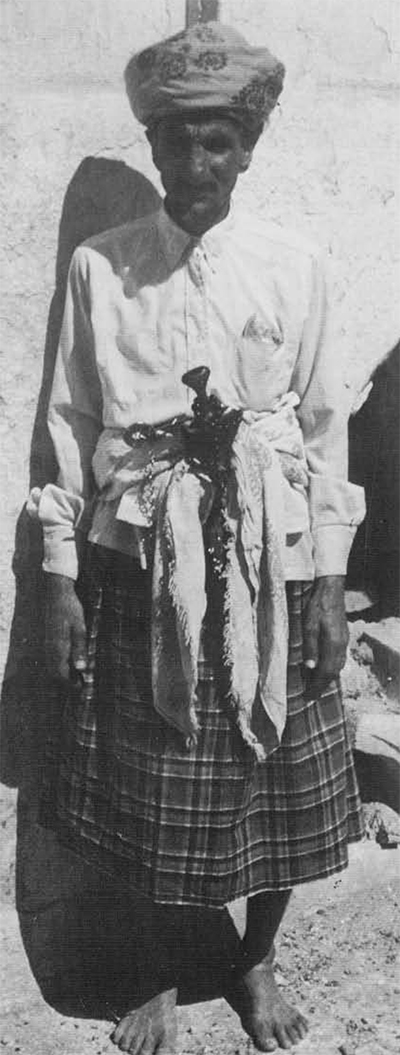
The hilts of horn, ivory, or even dark wood, were generally ornamented, at the center of the pommel and on the base, with two small disks of copper, silver, or gold. At first glance these looked like old coins; but the still-unused examples in the markets proved to be of very thin metal hollowed at the back. In addition, the top of the pommel and the grip were generally dotted with lines of small silver nail-heads, while the broad base was covered by, or bordered with, a narrow strip of worked copper or silver.
Such daggers are still being produced in Sanaa, the national capital. in two lanes of the old souq. The blades are individually forged and then fitted with a rough, temporary handle of soft white wood, which the buyer can replace with a hilt of his choice that fits comfortably in his hand. The sheaths—to be described in a moment—are provided by other shops in the same section of the bazaar.
At the present time, the making of dagger blades in any quantity seems to be pretty much confined to Sanaa. Elsewhere, little shops, small booths, or even roadside stands, selling dagger sheaths and ornamental belts to go with them, can be found in every village souq. and alI the principal towns have one or more of these shops in their market areas.
Even more frequent are the roadside stalls or temporary canopy-shelters for the blade-sharpeners, many of whom seem to be itinerant, travelling from town to town following the market days. The professional daggersmith takes the jambiya that needs sharpening and fastens it to a special board, carefully fitting the tip of the blade into a metal staple or ring in one of its lower corners, and securing the hilt to a handle at its top with a tight wrapping of leather thongs [Fig. 5). After he has finished doing one side of the blade, he unties the hilt, flips the blade over, and inserts the tip into another staple or ring on the opposite corner of the board, after which he fastens the hilt and begins again.
The actual process involves scraping off dirt and encrusted matter with a variety of small hand-chisels and scrapers, often removing thin slivers of metal in the process. Then the craftsman rubs the blade with pumice stone and completes the polishing process with various abrasive powders—dry, or mixed with oil or water to make a cream—until the steel gleams brightly. As a final touch, he may use a coarse file to produce a keener cutting edge. But nowadays the jambiya is more of a ceremonial object than a functional tool, being largely a token of manhood or a status symbol, so the daggersmith may merely sharpen the point, leaving the sides relatively dull.
It would be interesting to know exactly how the Yemeni metalworkers manage to harden the tips of their chisels and scrapers so they are strong enough to actually remove slivers from the blades, which are themselves of hard steel. This is only one of the questions that call for more intensive fieldwork, In fact, a detailed study of the actual forging of the blades, and the full treatment of the horn for the hilts, would provide valuable information, not yet available, regarding the traditional technology of this ancient land.
The people of Yemen have two secondary names for the jambiya: ‘asib and tuza. The first refers to the type worn by tribesmen and ordinary people in the towns, while the second is applied to those worn by the aristocrats or chieftains. Actually the knives are usually exactly the same in either case, but the two types have different kinds of sheaths, and each is worn in a distinctive way, as we shall see.
The foundation for the usual (‘asib type) sheath or scabbard consists of two flat pieces of wood, in the general shape of the blade but somewhat wider and longer, slightly hollowed in their inner surfaces and rounded on the outer edges. The two pieces are then fastened together with resin and covered with cloth or leather. Frequently this outer covering is further wrapped with narrow, brightly colored cloth tapes. These are wound around it in horizontal lines, often placed far enough apart to reveal the cloth or leather of the actual sheath but still sufficiently close to impart an overall impression of vivid color. Generally the end of the sheath is bent sharply upward toward the wearer’s right, to terminate in a rounded point. This has a practical advantage: it provides a hook to catch in the belt, so, if the dagger has to be suddenly drawn, it does not pull the sheath along with it [Fig. 6). Lastly, the scabbard would be finished off with a backing of coarse white cloth or white leather, where it would rest against the wearer’s body.


For decoration, the tops of the finer scabbards are often fitted with a broad metal band or collar, technically called the locket, usually of worked silver, engraved or pierced in scrollwork patterns or studded with small granules in geometric patterns. Some sheaths that I saw had locket-bands much wider than usual and set with nine flat, oval carnelians, or substitutes for these in dark red glass. I was told that this form of ornamentation was characteristic of the Bayda District, in the disputed border area to the southeast, a region that is now too politically troubled for foreigners to visit. In fact, the men who were wearing these distinctive sheaths were easily identified as coming from there, because they also had the typical Bayda-style “sitting bands,” recalling the cloth hands of similar function used by Indian yogis as supports during meditation, The Bayda men wore these draped over the left shoulder, as they strolled about in the bazaars of Sanaa or Taiz.
With or without the upper metal mounting, the `asib dagger sheath could be extended up or outward at the lower end, by a metal end-cap called the chape, In some cases a projecting chape would prolong the scabbard so far that its tip might reach nearly to the hilt. The usual type of chape generally terminates in a round knob or cone-shaped point, and they are made of a rather thin, tinny-looking silver alloy, cut through in simple shapes—often triangles—to expose the sheath facing of colored cloth or leather beneath it. The higher quality chapes are of thicker silver, sometimes gilded. Especially handsome are sheaths on which the chape has been carefully designed to complement a locket of similar material and design. This is not as common as one might expect, because often a man buys a chape, and then may have to wait years before he can afford to get a locket, made by someone else in a different style. The best silverwork was formerly done by Jewish artisans, so probably it is because most of the Yemeni Jews emigrated to Israel in 1948 that the delicate work of the older daggers—particularly the granulating—is no longer being done.
When all the basic work has been completed, and some of the trimmings added, the scabbard is generally permanently secured to a broad dagger-belt. In fact, the full jambiya outfit is not considered complete without such a belt. Some of these are rather simple, of plain leather decorated with metal eyelets. But anyone who can afford it prefers to have a handsome one, made of brown leather, lined with white cloth or softer white leather, like the back of the scabbard, and faced with heavy, colored silk cloth, brocaded or embroidered with gold or silver thread. This rich decoration is worked in bold arabesques, phrases from the Koran, or simple repeated designs. The belts that I saw being worn, or displayed in the bazaars, varied from three to five inches in breadth and were generally about three feet long. A small metal strap, pierced with holes, was fastened near one end to match a small buckle at the opposite extremity, so the wearer could adjust it to his comfort. This belt also helps to secure the knee-length skirt which in most districts is worn over the lower end of a European-style cotton shirt. Most men of any means wear over this a European jacket, left unbuttoned in front to display the jambiya. But the men of the lowlands, on the Tihama Plain, often leave off the jacket, and the belt as well, because of the heat, simply tucking the sheathed dagger into the top of their sarong-type skirt, called futa.

After the Revolution of 1962, which overthrew the rule of the hereditary Imams and created a republic, the old class distinctions were officially abolished, and theoretically, at least, any man can now dress pretty much as he wishes. But one still finds surviving relics of past sumptuary laws or long-accepted customs. One of these old traditions insisted that ordinary townsmen or men of the tribes should wear daggers of the ‘asib type set vertically at the front of the belt.
Most tribesmen, in particular, choose to wear these with the hilt and the upper part of the scabbard leaning outward at an angle of some 30° from the wearer’s body. In this position, the dagger can serve as. a convenient peg over which to hang things. We often saw jambiyas draped with a scarf, a towel, or a kufiya—the traditional Arab headcloth, which also serves many other purposes. With the sarong-type futa in the Tihama District, or the knee-length men’s skirt in the Yarim-Dhamar area to the north—both of which somewhat resemble a kilt—these dangling cloths, hanging down in front and coming together below the sheath, often recalled a Scotsman’s sporan. (See Fig. 8.)
In contrast to the commoners, the townsmen of high degree—seyyids and qadis, who were also set apart by their differing styles of formal headgear—traditionally wore their daggers and sheaths of the tuza-type set diagonally at the front of the belt, so that they slanted from the wearer’s upper left to his lower right (Fig. 9). Though the knives themselves were often quite plain, having the usual horn handle without undue extra ornamentation, the upperclass dignitaries generally wore them in rather ornate scabbards. These might be dark velvet with metal fittings, as previously described, or else made entirely of silver; but, whatever their substance or form of decoration, they were conservative in shape, lacking the exaggerated uptilt at the lower end. However, there may have been some exceptions in the past; because I did see in the Sanaa souq some antique examples in solid silver that had a highly abrupt curve and a long extension for the tip. It is possible, though, that these might have been brought in from beyond the frontiers, where people had other customs.
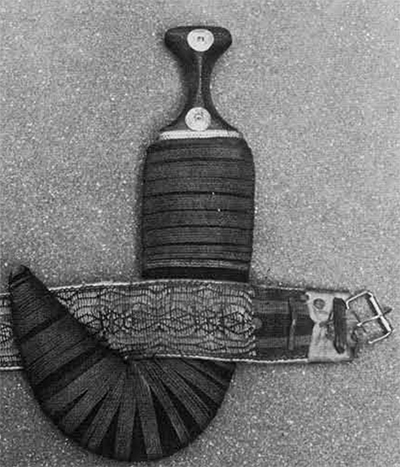
In travelling around the country, my guide-companion and I noted that the majority of Yemeni jambiyas belonged to the type just described, in either of the two traditional forms of sheath; but we also came across some rather striking regional variations. Although we were informed that the present increased mobility, with relative ease of travel from region to region in the overloaded sedans or LandRovers called “taxis,” or in open lorries, was rapidly breaking down the time-honored regional distinctions in the weapons, as well as in headgear and types of dress, certain forms of jambiya seemed still to be strictly local.
For example, in the Tihama Plain, which extends from the base of the high mountains to the shores of the Red Sea, silver dagger-hilts were quite common. One especially handsome type, with rather heavy though graceful lines, was described in other parts of the country as being of “Hodeida style.” However, when we visited the modern port-city of that name, we observed that most men there now wear modified Western clothing and have abandoned the custom of wearing daggers, so the “Hodeida daggers” can now be seen only in adjacent areas. The hilts of these silver “Hodeida daggers” are generally distinguished by having two prominent nail-heads projecting from the pommel and the base of the grip, and are decorated on the front surface with particularly rich granulations, often arranged in patterns of small triangles, while the relatively smooth, plain hack of the pommel often bears the name of the first owner, along with the date when he acquired it. For example, the one shown in Fig. 10 is engraved with the name Hassan Muhammad and the date 1358 A.H., which corresponds to A.D. 1939.
Another metal-hilt type that we saw in the Red Sea Coast area, especially in the region around Zabid, had three prongs at the top: one pointing straight up, the other two arching out and downward on either side, like eagles’ beaks. The workmanship on these showed designs similar to those on the “Hodeida daggers,” somewhat more coarsely executed; but both of these types had the same kind of blade as those with the more common horn handles.
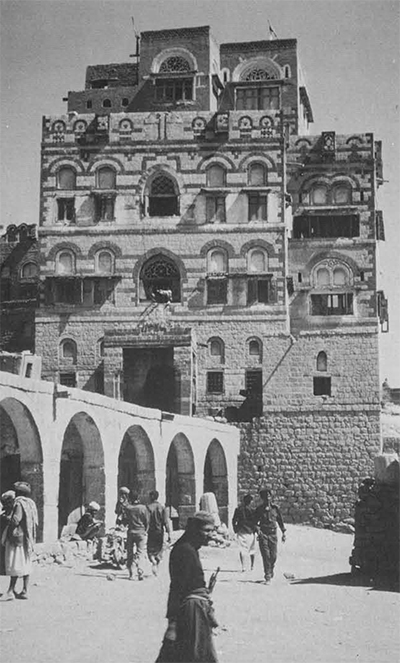
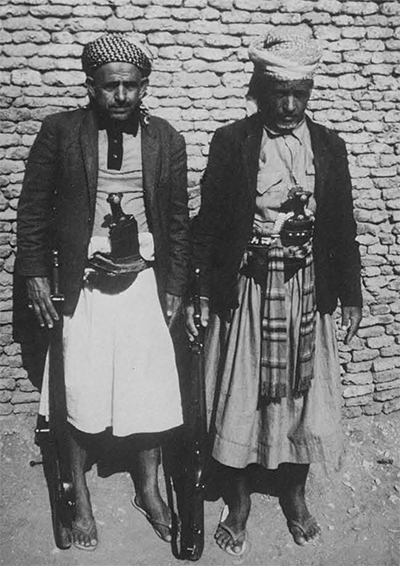
In the coastal districts I did not see any of these metal-hilted daggers being carried in metal scabbards. Instead, their wearers seemed to prefer simple wooden sheaths covered with cloth—especially, modern imported silks in bright colors, lavishly ornamented with false brocading in silver or in imitation gold (Fig. 11). These were colorful but garish, even in that exotic setting where brilliant hues were exceedingly popular. This choice may have merely been inspired by a current fashion encouraged by the Indian merchants in Hodeida; but quite possibly it was done for a practical reason, since a metal sheath against one’s body could easily become too hot for comfort in the tropical heat of the Tihama District. However, I did see one or two of the “Hodeida daggers” in matching metal sheaths, in the curio shops that have recently sprung up in the Sanaa Bazaar to take advantage of the budding tourist trade.
These Sanaa shops, though, are generally not the place to study authentic jambiya types, as very few of the daggers on view there still have their original scabbards, and most of them are obviously mismatched. Either the jambiya-wearers are too proud of finely made, well-matched daggers to part with them, or the curio dealers must have acquired daggers and sheaths separately and have simply put together mismated combinations calculated to attract the tourist’s eye. Since most jambiyas in their ordinary sheaths are rather plain, an ordinary one can be made to seem more attractive in a better scabbard, while the finer daggers look sufficiently appealing in simple sheaths; thus a canny dealer can double his opportunities for profitable sales.
In spite of all this, the shops in the Sanaa souq sometimes have a few notable exceptions to these mis-mated sets: for example, jambiyas from the Bedouin tribes who live in the far north of Yemen, or over the border in the Najran District or Asir Province, parts of historic Yemen that were recently taken over by Saudi Arabia. These northern daggers are fully silver-mounted. Their relatively plain pommels are either simply rounded or double-pointed, and their distinctive scabbards are L-shaped, ending in a short, bluntly-rounded point which juts out toward the wearer’s right. Their scabbards are also fairly plain, most of the decoration being provided by metal cords or chains across the middle, linking together large silver rings that are attached directly to the front surface of the belt.
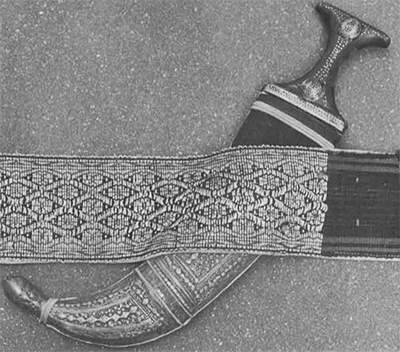
In Saada, at the weekly souq, which is held every Sunday, we also met Saudi Arabians wearing much longer “Wahabi knives” that resembled small swords. Due to their excessive length, these had to be passed through the belt at an angle, like the tuza daggers of the Yemeni aristocracy; but they proved to be vastly inferior to the latter, as they had plain, ribless blades, and hilts and scabbards of poor quality metal.
Nowadays, the men of Yemen seem to be wearing daggers as a mark of manhood, or as a kind of status symbol. It has not always been so. In “the old days,” before 1962, they were frequently used for combat or defense, as occasionally they still are. A comment in a British Intelligence report on Yemen, written earlier in this century, remarks of the jambiya, “The Arabs are very expert in its use; they hold it point downwards with curve inward, and in attacking always aim at the supra-sternal notch (at the base of the neck), a blow which, if rightly placed, splits open the whole chest wall, and is instantly fatal,” Other accounts speak of parading troops singing in high-pitched falsetto as they performed the Dagger Dance. Such demonstrations probably provided a means of rehearsing practical strokes and parries—as did the traditional Chinese sword dances—in addition to serving as an emotional display of military fervor.
There is ample reason to suppose that in the past a Yemeni male would be presented with a jambiya, or at least given the right to wear one, in the course of some kind of coming-of-age ceremony. In other Muslim lands, boys of twelve to fourteen years traditionally underwent ritual circumcision, after which they were considered to have attained manhood and could assume the right to wear a man’s headgear and to carry a sword or rifle. Probably the right to wear a dagger was formally granted at the same time. This would no longer apply in the upland portions of Northern Yemen, where—as in modern Ethiopia—the circumcision is performed shortly after birth; but it seems still to be true in the Tihama. There, boys are circumcised in their early teens, after which they can wear a jambiya.
There, in the Tihama, jambiya-wearing seemed to be an event that was eagerly anticipated. Small boys, the world over, tend to sketch on walls little pictures of things they would most like to have, such as bicycles or motor cars; but I noticed in at least one Tihama town (Bell al-Faqih) that the youngsters’ graffiti most often represented jambiyas —both the usual type and those with Zabidstyle hilts. Apparently, the incipient artists were looking forward to the time when they, too, would be permitted to wear them.
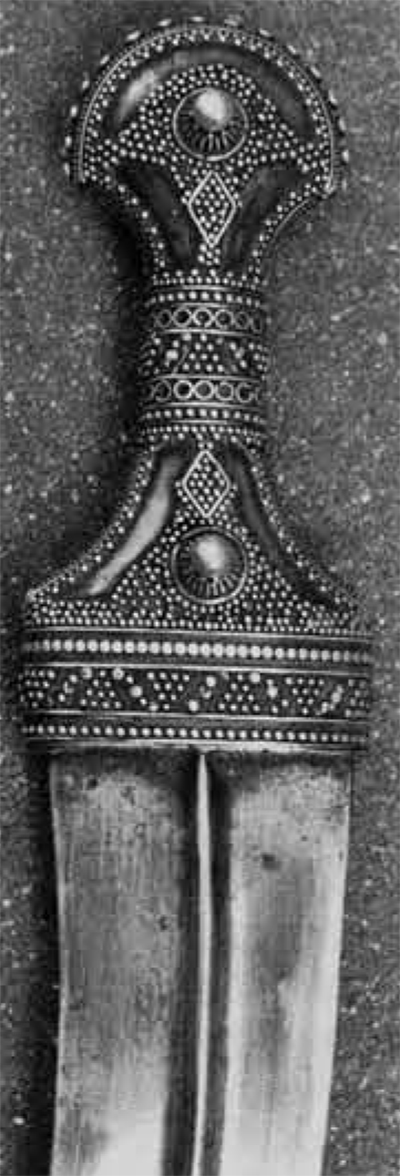

Whatever the circumstances of acquiring them might have been, I noticed that, in general, the wearing age now seems to begin about the age of fifteen or sixteen—the time for traditional rites of puberty—except among the sophisticated young townsmen, who consider dagger-wearing “old fashioned.” But in Saada, in the more conservative North (some five hours above Sanaa by motor transport), small boys of only eleven or twelve were strolling through the Sunday souq proudly wearing jambiyas that were much too large for them.
Since the jambiya itself now seems to be worn primarily for display, many men carry, tucked into the belt behind its sheath, a smaller, sharp-edged knife for general utility, sometimes accompanied by an automatic pencil or a ball-point pen. These accessories are often loosely covered by a hollow silver tube with an ornate top, shaped like a sword-hilt. Although the merchants in the souqs now refer to the latter simply as “knife covers,” I strongly suspect that they must have originally served as hilts for the now-obsolete Arabian-style sabers, which men ceased to wear after the change of government in 1962. The fact that these hilt-shaped “knife covers” never really fit the secondary knives and are usually large enough to contain other things as well, convinces me that they were intended for some other use, and they do exactly resemble the distinctive shape of the traditional Arabian sword hilts. Though the few antique swords now offered for sale in the Sanaa antique shops are shabby things, with simple hilts of wood or bone, these same hilts usually have three vertical projections at the top, which is a distinguishing feature on many of the silver “knife covers,” and they are the same relative size as the latter.
We occasionally came across a man wearing an empty sheath, without the jambiya. This could be accounted for in several different ways. Sometimes the dagger itself might have been pawned or stolen. The considerable number of sheathless jambiyas being offered for sale by shady-looking characters in Sanaa souq’s “Thieves’ Market” would tend to support this. In other cases, the man with the empty sheath might have had his jambiya taken away from him by the town authorities. This is often done when a man is recognized as being dangerously mad (majnun), or has a criminal record. Lesser offenders serving jail sentences are permitted to wander around the streets by day, wearing iron leg fetters, as long as they return to prison at night, and naturally these were not permitted to wear daggers. Lastly, both parties engaged in a law case are required to give up their daggers, for security, pending the court’s decision. Incidentally, this also removed the temptation to take the law into their own hands with the jambiyas.
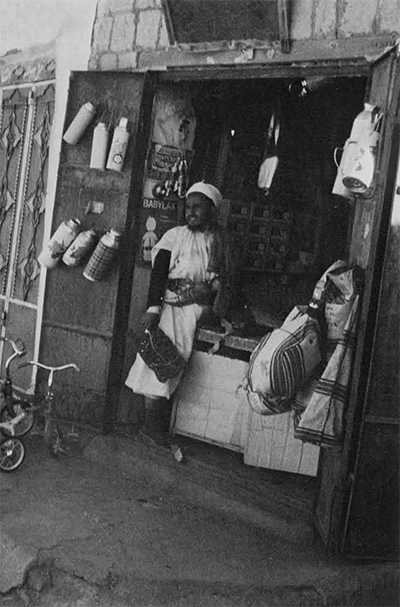
One final instance of the ceremonial use of the jambiya involves their ritual importance in the taking of oaths or making contracts. We actually witnessed such an undertaking in a tea house in Saada. Two bearded old men, each having two companions who were apparently serving as witnesses, were deeply involved in an argument on opposite sides of a long table at which we also were sitting. The loud conversation suddenly stopped, and both of the old men smiled. Each of them drew his jambiya from its sheath, and after crossing first the blades, then the hilts, and making other motions too fast and too complex for us to follow in detail, they laid them on the table between them. Then, after a few more words each resheathed his dagger. After one more rite, they all walked off in apparent agreement.
The concluding act of the oath-taking did not directly involve the jambiyas but it did have important significance as a cultural survival. Three of the men, one of the principals and his witnesses, reached across the table and touched the lap of the other old man, below his dagger sheath, as he giggled nervously. This final ritual gesture, “to seal the oath,” like the rite of circumcision, is traced back to their traditional ancestor, Abraham, in a line descending from Ishmael. (See the Encyclopaedia of Religion and Ethics, vol. 9, pp. 436-37, text and notes.)
Not only in oath-taking but also in many other ways, the cult of the jambiya is bound up with many still older traditions. The two types of dagger, ‘asib and tuza—differing only in their sheaths and the manner in which they are worn—still play a part in the social life of Yemen as well as in the lives of individual Yemenites. As we have seen, although the plain steel blade with its prominent midrib is used almost everywhere, the forms of the hilts and the sheaths still present distinctive local variations. However, the latter are gradually breaking down as the population becomes more mixed, due to the increasing mobility provided by new roads and motor transport. Doubtless, too, the increasing tendency toward modernization in the larger cities, leading toward adoption of Western-style clothing and customs, will soon render obsolete these picturesque weapons, which still survive as relics of a more militant past.
